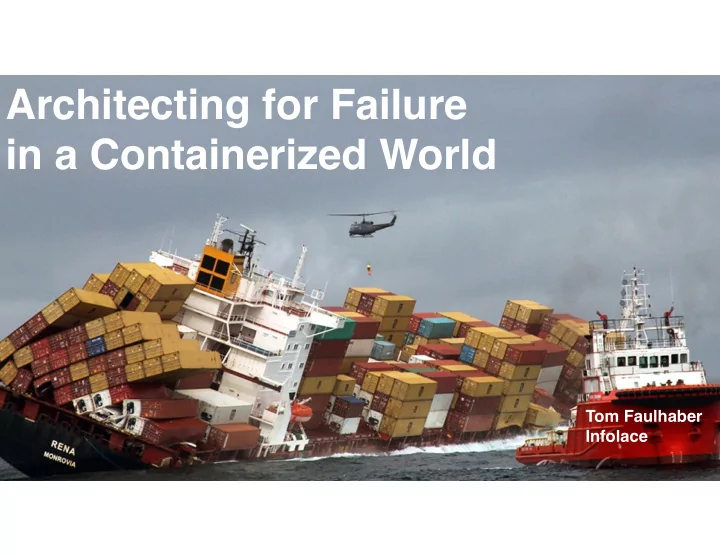

Architecting for Failure in a Containerized World Tom Faulhaber Infolace
How can container tech help us build robust systems?
Key takeaway: an architectural toolkit for building robust systems with containers
The Rules Decomposition Orchestration and Synchronization Managing Stateful Apps
Simplicity
Simple means: “Do one thing!”
The opposite of simple is complex
Complexity exists within components
Complexity exists between components
Example: a counter x … 5 5 0 0 1 1 2 2 3 3 4 4 Counter Counter Service Service … 0 1 2 3 4 5 Counter Service 0 1 2 3 4 5 0 1 2 3 4 5
Example: a counter … 5 0 1 2 3 4 Counter Service Balancer Load … 0 1 2 3 4 5 Counter Service 0 0 1 2 1 2 3 3 4 5 4 5
State + composition = complexity
Part 1: Decomposition
Rule: Decompose vertically
App Server Service Service Service #1 #2 #3
App Server
Rule: Separation of concerns
Example: Logging App Logging Server Core Code Logging Driver Config
Example: Logging App Core Code Logging Server StdOut Logger Logging Driver Config
Aspect-oriented programming
Rule: Constrain state
Session Store Relational DB
Rule: Battle-tested tools
Redis MySQL
Rule: High code churn → Easy restart
Rule: No start-up order!
a b c d time
a b c x d time
x a x b x c x d time
x a x b x c x d time
a b c d time
a b c d time
a b c d time
Rule: Consider higher-order failure
The Rules Decomposition Orchestration and Synchronization Decompose vertically Separation of concerns Constrain state Battle-tested tools High code churn, easy restart Managing Stateful Apps No start-up order! Consider higher-order failure
Part 2: Orchestration and Synchronization
Rule: Use Framework Restarts
• Mesos: Marathon always restarts • Kubernetes: RestartPolicy=Always • Docker: Swarm always restarts
Rule: Create your own framework
Mesos Master Mesos Mesos Mesos Agent Agent Agent Framework Driver Framework Framework Framework Executor Executor Executor
Rule: Use Synchronized State
Synchronized State Tools: Patterns: - zookeeper - leader election - etcd - shared counters - consul - peer awareness - work partitioning
Rule: Minimize Synchronized State
Even battle-tested state management is a headache. (Source: http://blog.cloudera.com/blog/2014/03/zookeeper-resilience-at-pinterest/)
The Rules Decomposition Orchestration and Synchronization Decompose vertically Use framework restarts Separation of concerns Create your own framework Constrain state Battle-tested tools Use synchronized state High code churn, easy Minimize synchronized state restart Managing Stateful Apps No start-up order! Consider higher-order failure
Part 3: Managing Stateful Apps
Rule (repeat!): Always use battle-tested tools! (State is the weak point)
Rule: Choose the DB architecture
Option 1: External DB Execution cluster Database cluster
Option 1: External DB Pros Cons • Somebody else’s problem! • Not really somebody else’s problem! • Can use a DB designed for • Higher latency/no reference clustering directly locality • Can use DB as a service • Can’t leverage orchestration, etc.
Option 2: Run on Raw HW App App App Marathon Marathon Marathon Mesos Mesos Mesos HDFS HDFS HDFS
Option 2: Run on Raw HW Pros Cons • Use existing recipes • Orchestration doesn’t help with failure • Have local data • Increased management • Manage a single cluster complexity
Option 3: In-memory DB App App App MemSQL MemSQL MemSQL Marathon Marathon Marathon Mesos Mesos Mesos
Option 3: In-memory DB Pros Cons • No need for volume tracking • Bets all machines won’t go down • Fast • Bets on orchestration • Have local data framework • Manage a single cluster
Option 4: Use Orchestration Mesos Mesos Mesos App App App Marathon Marathon Marathon Cassandra Cassandra Cassandra
Option 4: Use Orchestration Pros Cons • Orchestration manages • Currently the least mature volumes • Not well supported by vendors • One model for all programs • Have local data • Single cluster
Option 5: Roll Your Own Mesos Mesos Mesos Mesos Master Framework App App App Marathon Marathon Marathon ImageMgr ImageMgr ImageMgr
Option 5: Roll Your Own Pros Cons • Very precise control • You’re on your own! • You decide whether to use • Wedded to a single containers orchestration platform • Have local data • Not battle tested • Can be system aware
Rule: Have replication
The Rules Decomposition Orchestration and Synchronization Decompose vertically Use framework restarts Separation of concerns Create your own framework Constrain state Battle-tested tools Use synchronized state High code churn, easy Minimize synchronized state restart Managing Stateful Apps No start-up order! Consider higher-order Battle-tested tools failure Choose the DB architecture Have replication
Fin
References • Rich Hickey: “Are We There Yet?” (https://www.infoq.com/presentations/Are-We- There-Yet-Rich-Hickey) “Simple Made Easy” (https://www.infoq.com/presentations/Simple- Made-Easy-QCon-London-2012) • David Greenberg, Building Applications on Mesos, O’Reilly, 2016 • Joe Johnston, et al. , Docker in Production: Lessons from the Trenches, Bleeding Edge Press, 2015
The Rules Decomposition Orchestration and Synchronization Decompose vertically Use framework restarts Separation of concerns Create your own framework Constrain state Battle-tested tools Use synchronized state High code churn, easy Minimize synchronized state restart Managing Stateful Apps No start-up order! Consider higher-order Battle-tested tools failure Choose the DB architecture Have replication
Recommend
More recommend